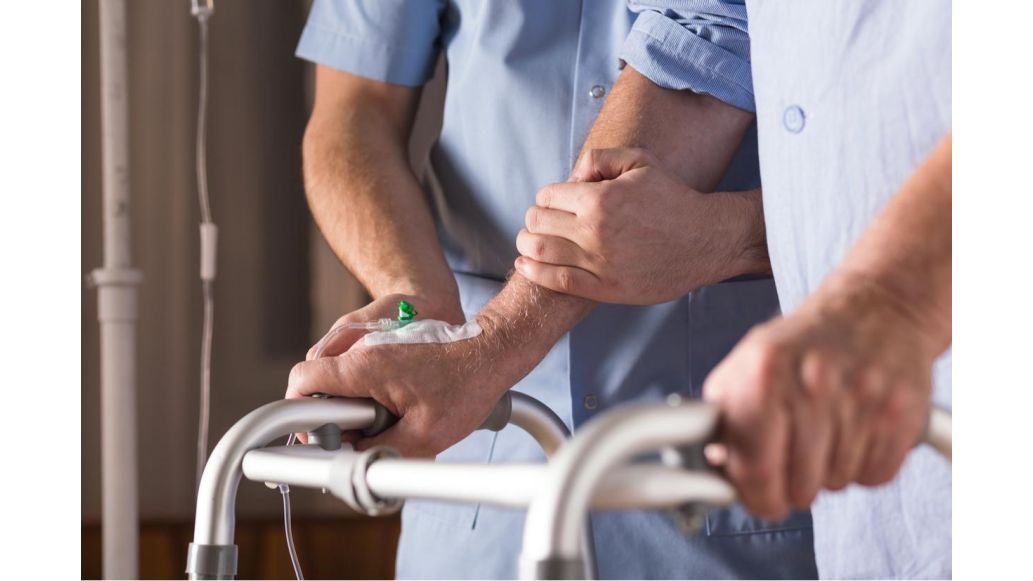Hospitals are a place where patients come to receive treatment. No medical professional wants to see their patients get hurt while under their care. Fall prevention strategies can reduce your patients’ risk of falling and keep them safe while in the hospital and under your care.
Common Questions About Falls in Hospitals
5 Proven Fall Prevention Strategies
Universal Fall Precautions
Patient Specific Fall Prevention Interventions
Patient Education
More Fall Prevention Resources
Common Questions About Falls in Hospitals
How common are falls in hospitals?
The Agency for Healthcare Research and Quality estimates that every year 700,000 to 1 million hospitalized patients fall.1
How many falls in hospitals result in injuries?
More than 1/3 of fall in hospitals result in injury, including serious fractures and head trauma.1
What is a DRG payment for hospital services?
DRG (diagnosis-related grouping) is how Medicare and some insurance policies pay hospitals. Medicare pays hospitals a fixed amount depending on the patient’s DRG rather than the actual cost the hospital spent on a patient. This means sometimes a hospital makes a profit on a patient, if the treatments and care cost less than the DRG payment, and sometimes they lose money, if it costs more than the DRG payment. Patient falls can affect a hospital’s DRG payment.
Why are falls one of the HACs (hospital-acquired conditions) included as a part of the DRA(Deficit Reduction Act)?
In 2006, President George W. Bush signed the Deficit Reduction Act (DRA) of 2005. The act identified conditions that were high cost and/or high volume which result in the patient case being assigned to a DRG (diagnosis-related group) that has a higher payment when present as a secondary diagnosis, and could reasonably have been prevented through the application of evidence-based guidelines.2
Hospital falls with trauma were included as one of the HACs (hospital-acquired conditions) included on the list.
How do falls affect a hospital’s DMG payment?
As of October 1st 2008, hospitals no longer receive additional payment from Medicare for selected HACs (hospital-acquired conditions), including falls with injury (including fractures, dislocations, intracranial injuries, crushing injuries, burns, and other injuries).2, 3 This was done to incentivize hospitals to take steps to prevent these conditions from occurring. This is one reason why fall prevention is so important in hospitals.
Why are falls without injury also serious?
Even if a patient falls without injury, resulting in a "no harm" fall, it can still have negative effects. These falls can result in fear, distress, and anxiety in patients.
They can also start a negative cycle where patients are afraid to fall, so they restrict their activities to avoid falls. This then causes the patient to lose strength and independence - increasing their risk of falling again.
Why are hospital patients at a higher risk of falling?
Several factors increase the risk of patient falls in hospitals. One factor is that hospital rooms are unfamiliar environments. Another is that some patients are taking medications that may make them dizzy or confused. Additionally, the conditions that lead to patients being in the hospital or the tests and treatments they are undergoing may also leave patients feeling weak or unsteady. These factors, in addition to existing difficulties with mobility and balance, can leave your patients at risk for falls.
Do fall prevention programs work? What does the research say?
Study: Effectiveness of targeted falls prevention programme in subacute hospital setting: randomised controlled trial6
Participants: 626 men and women, 38-99 years old (average age 80 years old) from consecutive admissions to subacute hospital wards
Intervention: Patients in the intervention group received a targeted fall prevention program in addition to regular care. The program included a falls risk alert card, an informational brochure, an exercise program, an education program, and hip protectors.
Results: Compared to the control group, 22% fewer participants in the intervention group fell and there were 28% fewer falls with injuries. Overall, the study concludes that a multiple intervention falls prevention program reduces the incidence of falls in a sub-acute hospital setting.
What fall prevention measures is each member of the Unit Team responsible for?
Clear policies and responsibilities help ensure all fall prevention measures are taken to protect your patients. These roles may vary depending on your staffing configuration.
Nurse
- Complete and documents fall risk screening and assessment
- Document fall prevention practices for individual patients
- Monitor changes in patient’s medical condition
- Report falls to medical provider/physician
- Supervise aides
- Obtain medical orders as needed
- Educate patient and family on fall prevention
- Obtain needed supplies to prevent patient falls (ex. walker, bed alarm, etc.)
Nurse Aide
- Evaluate the safety of the patient's environment during care tasks
- Perform appropriate care plan tasks and reports when they are complete to nurse
- Report changes in patient’s medical condition to nurse
Physician
- Evaluate patient need for specific types of rehabilitation therapy
- Review medications for fall risk and make changes if necessary
- Write orders for specific fall prevention interventions (including activity orders)
Pharmacist
- Review medication of patients that are a high fall risk (based on medication profile) and suggest alternatives meds or dosages to medical providers
Physical or Occupational Therapist
- Make recommendations and trains patient on how to use mobility aids and adaptive equipment
- Provide therapy to patients to improve mobility and ability to perform activities of daily living
- Review activity orders and asks physician to adjust as needed
5 Proven Fall Prevention Strategies
Mercy Health-Anderson Hospital in Cincinnati, OH reduced its fall rate in their med/surg unit from 10 falls per 1,000 patient days to 2 falls per 1,000 patient days over three years.5 They did this by following a Transforming Care at the Bedside (TCAB) program that targeted patient falls.
These are some of the strategies they used to reduce fall rates at their hospital.
1. Easy Identification of High Fall Risk Patients
- High-risk patients were identified in three ways, so staff could quickly initiate the proper protocols
- They all wore red socks
- High-risk patients also wore armbands
- Visual cues were posted outside of fall-risk patients’ doors
2. Bed Alarms
- Anderson Hospital set their bed alarms so they sounded after one or two seconds instead of ten to reduce the amount of time patients could be out of bed before staff was aware and could intervene.
3. Safety Rounds
- In addition to hourly rounds, nurses conducted twice-daily safety rounds on high-risk patients. During this effective intervention, nurses made sure fall precautions were in place (socks, armband, sign, and alarm).
4. Keeping Patients Busy
- Hospital staff gave patients activities to do to keep them occupied and less likely to get out of bed due to boredom.
- Staff also educated the patient’s family on fall prevention.
5. Provide Safety Companions
- Anderson Hospital increased the number of safety companions who provide continuous monitoring and aid to disoriented patients who were unable to follow direction to help prevent falls.
While all of these solutions may not be the right fit for your hospital, they provide a helpful starting point. Incorporating some of these steps in a universal fall precautions program can help reduce the number of patient falls in your hospital.
Universal Fall Precautions
Universal fall precautions are safety measures that are taken to reduce the chance of falls for all patients, regardless of individual fall risks. Precautions may vary from hospital to hospital, but here’s a list to get you started. These are the components most often see in successful fall prevention trials1:
- Multidisciplinary responsibilities, not solely nurses, but physicians, physical therapists, pharmacists, occupational therapists, and patients and their families too
- Reviewing medication and when appropriate discontinuing the use of medications that are associated with a higher fall risk (psychotropic medication, medication with dizziness or lightheadedness as side effects, etc.)
- Continence management, including frequently offering assistance to use the toilet, commode, or bed pan
- Focusing on preventing, detecting and treating delirium, including testing for urinary tract infections
- Access to mobility aids if necessary
- Provision of safe footwear (not just advice on safe options)
- Early access to physiotherapists and exercise
- Structured staff education from a health professional
- Patient education
Patient Specific Fall Prevention Intervention
In addition to universal fall precautions, it’s important to tailor interventions to individual patient needs. A fall risk assessment can help you identify patients that have a high fall risk and implement patient-specific solutions.
For example, if the patient forgets to call for assistance when walking, using a bed alarms can alert nurses to intervene before the patient falls. Or if the patient has had a recent fall, discussing how it happened and what to do to prevent a similar fall in the future can help. Having the patient wear hip protectors may also be a good precautionary choice.
These interventions will vary from patient to patient depending on their individual conditions and risk factors.
Patient Education
Patient education is another important part of reducing patient falls, both in the hospital and once patients return home.
Educate patients on why they are at risk for falls and how they can reduce their chance of falls and injuries. Make them aware of the universal precautions that are in place and the steps that have been taken to prevent falls based on their individual risk. A fall prevention handout can be an easy way to start their education.
Hospital staff can re-emphasize key components of the patient’s individualized prevention plan during rounds and rehab sessions (like using the call light instead of getting up alone) to remind patients to follow these interventions.
More Fall Prevention Resources
Looking for more information on preventing falls? Learn more about fall prevention here.
References
Medical Disclaimer: The information provided on this site, including text, graphics, images and other material, are for informational purposes only and are not intended to substitute for professional medical advice, diagnosis or treatment. Always seek the advice of your physician or other healthcare professional with any questions or concerns you may have regarding your condition.








 France
France Australia
Australia



